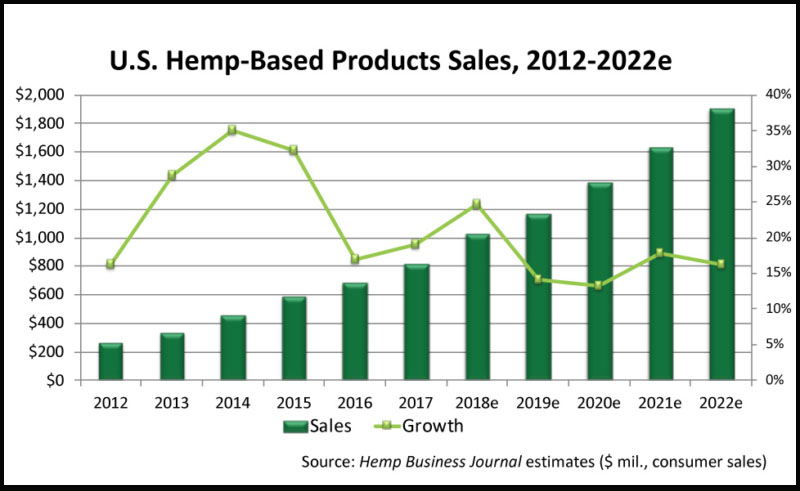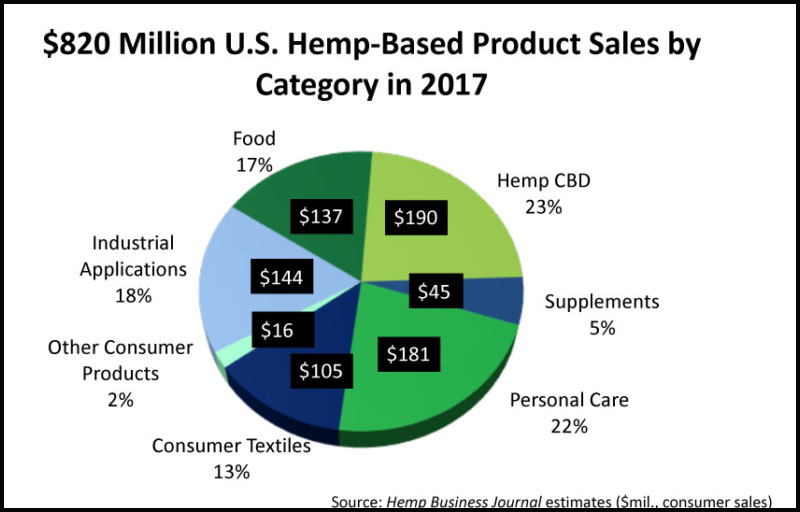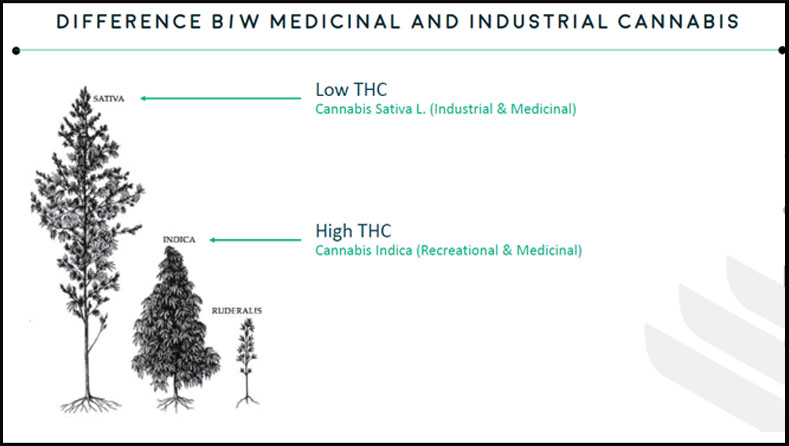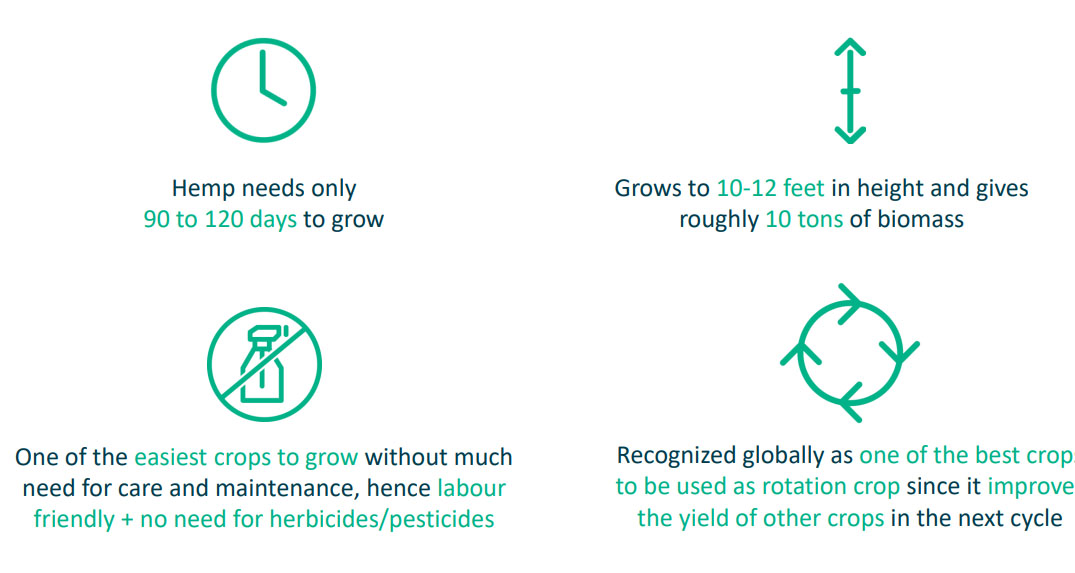HW Community
Misconceptions keep Himachal from making fortune on ‘green gold’ and eradicate charas mafia

Shimla: Owing to the unawareness and lack of education regarding the difference between hemp and recreational cannabis and the political link between the two, Himachal Pradesh Government is missing a big opportunity to cash on it. Hemp cultivation has become green gold in countries like China and the United States of America. The best part is that its biodegradable, thus, eco-friendly.
At the same time, while sitting on this mine of green gold, the Hill State is facing the wrath of charas/drug mafia due to illegal cultivation in rural areas where people have bleak opportunities of alternative employment.
The public, as well as the government, are under the false impression that legalizing cultivation would make things worse, especially for the youth. The article discusses facts relating to this misconception created due to the negative image of the plant. But before that, let us take a look at the booming industry of hemp.
Overview of the booming global hemp market
As of 2017, around 36 countries were growing industrial hemp in accordance with rules and regulations of their respective governments.
Hemp is endorsed in fibre market by big names like Adidas, Nike, Specialized Bicycle, MERIDA, TREK, Capo, Assos, Rapha, Marcello Bergamo, Castelli etc.
Hemp fibre accounted for 40.4% of the revenue in 2017 on account of high demand from the textile industry.
The global industrial hemp market is booming and expected to reach USD 10.6 billion by 2025, says a report by Grand View Research, Inc.
It’s generating billions in revenue and creating investment opportunities. China is the biggest producer as it claims 50 percent of the total supply to the global market. China’s hemp industry is all set to grow into a US $14,66,49,10,000 fortune in just five years.
China is fetching US $1,500 per hectare which is higher than the common crops like corn. Its produce is mostly exported to US, Europe, Japan, Korea, Hong Kong, etc.
Shanxi Greenland Textile is the largest hemp fibre processor in China.
While Indian policymakers are neglecting it, about 606 patents have already come into existence, and China holds maximum 309 patents relating to hemp products.
In the US, Hemp Business Journal predicts industry growth of 700% to a value of 1.8 billion dollars by 2020 owing to hemp-derived CBD, food, personal care and industrial products
The total sales for the U.S. Hemp Industry in 2017 were $820 million.
Hemp is useless for charas mafia
When American farmers first begin to grow hemp as a legal crop, a large number of other people believed they were growing drugs or cannabis for smoking. This is the biggest misconception faced by the policymakers in India as well as in other nations.
Hemp is one of the varieties of Cannabis sativa, which cannot be used as a psychoactive substance to get high. In simple words, it would not get you high even if you try to do so by smoking it because it contains negligible amount (.3%) of the psychoactive substance Tetrahydrocannabinol (THC).
This variety of cannabis family is different from what is being cultivated illegally in Himachal, which contains a much higher amount of THC.
Genetically modified seeds with low TCH content
The researchers are already working on developing genetically modified hybrid seeds which could deliver higher productivity with a negligible amount of THC. Similar efforts are being made in the neighbouring states of Uttarakhand and Jammu & Kashmir where the hemp cultivation has already been made legal. However, the stigma associated with cannabis family is holding back the hemp industry.
However, the misunderstanding due to the link of hemp to the cannabis family has resulted in several restrictions on hemp cultivation, processing, distribution, and consumption.
Himachal’s policymakers should not make a similar mistake and spoil the chances of socio-economic upliftment through this green gold.
Recreational cannabis can’t be grown under cover of hemp
Countries cultivating hemp has not faced any such problems because these two types of cannabis varieties can be distinguished easily. Also, the cultivation cycle is also different from the recreational cannabis. Moreover, the cultivation area, which is beyond government’s complete surveillance throughout the year, would automatically provide all details regarding the total area of cultivation with specific locations, total produce, and sale to manufactures.
Considering this, anyone who is given license to cultivate hemp legally after fulfilling all official formalities and conditions would deter from violating it by trying to cheat the authority.
Recognized and listed in the Essential Drugs List of AYUSH
The Essential Drugs List of Ayurveda Siddha Unani and Homeopathy (AYUSH) Department includes cannabis sativa as a medicine and the ancient literature of India as well China has a plethora of documented knowledge about the medicinal properties of the plant.
It is written in our Vedas that Cannabis (Vijaya) is one of the most sacred plants to grow on this land. Our Ayurvedic scriptures recognised and wrote about the miraculous medicinal properties of this plant almost 3,500 years ago.
Vijaya has been described under Upasiva Varga (Group of sub-poisonous plants) by certain texts related to Rasa Sastra.
Take a detailed look at a research titled “Exploring the pharmaco-clinical view on Bhanga (Cannabis sativa linn.): a classical unfamiliar portrayal Swagat” by DilipTavhare and Rabinarayan Acharya published in International Journal of Pharmaceutical & Biological in 2015:
A large number of such studies is available to testify in support of the aforesaid facts.
A global cannabis market of billions of dollars is ready to make large investments in India with a potential of creating employment for approximately 2.8 million people.
The cultivators can earn approximately Rs, 40,000 per acre in 100 days. Further, India has a potential to export hemp and cannabis products worth $330 million, which could grow rapidly if the government could think in the right direction and open research facilities to study this plant.
As per the Canadian Hemp Trade Alliance, in 2016, Canadian exports of hemp rose from $600,000 to $45 million and is expected to grow to $40 – $80 million by 2020.
Companies in the market are producing fibres that are water repellent, fire retardant, absorptive, and super soft. China was the first to carry out a research on hemp and use it in the military for uniforms and bulletproof jackets.
As a matter of fact, the hemp fibre is considered as one of the strongest material.
Hemp is so strong and lightweight that the auto industry is using it for luxury car parts.
It also makes good construction material in homes, and researchers are of the opinion that hemp biodiesel could one day be used as clean fuel.
The market boom can be attributed to increasing awareness about hemp, thus, growing demand for hemp-based food products including cooking oil, dairy alternatives, flour, salad, and for bakery products such as bread and cookies
What does HP High Court say about hemp cultivation?
If the data provided in a Public Interest Litigation (PIL) filed in the State High Court by advocate Deven Khanna is considered, Himachal can kill several birds with one stone if it could bring the cultivation of hemp under legal framework for industrial and medicinal purposes.
A bench of Acting Chief Justice Sanjay Karol and Justice Sandeep Sharma, on July 19, after taking stock of the situation of the state in terms drug/substance use, had expressed worries about it saying the situation has reached an alarming level.
The Court has directed the government to take every possible measure including at the level of policymakers to eradicate this nuisance. Along with directions to law enforcement agencies, the court has also asked the government to consider cannabis cultivation for alternative purposes, especially medicinal.
Government may also consider hiring services of some research Agencies, who in turn may advise/recommend alternate use, especially medicinal use, if any, of cannabis plant grown in the State of Himachal Pradesh, so that local residents, involved in illegal trade of cannabis, are encouraged to use cannabis plants for producing some medicines or substances which can be used legally,
the court had stated in the order.
ND&PS Act has given powers to State Governments to legalise hemp cultivation.
On the top of these advantages including the positive response of the High Court, there is already a provision in the ND&PS act, which the government can use to allow hemp cultivation.
Section 14 of the ND&PS Act empowers the government to, by general or special order, permit cultivation of cannabis exclusively for horticultural and industrial purposes. It says that the Central Government shall encourage research and trials of cultivars of cannabis with low THC content. The Central Government shall, however, follow a cautious, evidence-based approach towards the cultivation of cannabis for horticultural and/ or industrial purposes and shall take decisions based on the result of researches.
The Section 10 of the Act when read with Section 8, empowers the state governments to licence cultivation of cannabis for medical and scientific purposes.
Hemp cultivation is very specific in terms of its requirement for the climatic conditions.
As the altitude and climatic conditions of the Hill State favour cultivation of cannabis, the plants could be found in almost every region from tribal areas to International tourist destinations like Kullu and Shimla.
This alternative can also eradicate charas/hashish mafia – one of the biggest concerns of Himachal.
Also, as the hemp has no natural enemies like animals, insects, pests etc, farmers do not need to worry about the damages worth hundreds of crores caused to their crops by wild animals or making expenditure on pesticides.
Himachal’s struggle to check drug/substance abuse nuisance
If we take a look at the current situation, in district Shimla only, the police have registered about 24 cases under the Narcotic Drugs & Psychotropic Substances (ND&PS) Act from July 1 to August 8, 2018. In July, about 70 percent of cases were registered against Heroin (Chitta) offenders other than Charas, opium, and other drugs.
However, in August, the Shimla Police seized a high quantity of Charas in two cases, which could be considered as significant achievements. On August 8, police allegedly nabbed three persons including a female with 8.143 kg of Charas, and the case was registered at the Police Station, Theog.
Earlier, on August 2, the police had got it hands on a person who was allegedly carrying 3.3 kg charas.
However, such a high number of cases under ND&PS also indicate a commercial level cultivation of cannabis illegally. Ironically, the government is spending on uprooting these crops.
As per the Director General of the Police, SR Mardi, 94.267 kg charas was recovered between April, May and June 2018.
As per the DGP’s affidavit submitted to the court,
In the year 2012, 282.370 Kgs. charas was recovered from Himachal, whereas in the year 2013, it increased to 314.962 Kgs. As per the ‘NCB’, 356.963 Kgs. charas was recovered in the year 2014.
In 2016, the amount of seized charas rose to 377.535 kgs and 134 kg charas in first seven months of 2017.
Replacing current cannabis variety with hemp could go a long way in checking this nuisance and the black market.
Need for crop diversification in Himachal
Further, the climate change has affected Himachal’s common crops and fruit crops, especially apple. Amid such times, the policymakers need to work for diversification of cultivation of crops so that a supplementary income could be provided through the cultivation of Hemp in a rotational growing cycle along with major conventional crops.
It’s needless to say that hemp cultivation in addition to the common crops could assist it in achieving its target of doubling the income of farmers.
Major challenges for the hemp industry in India
The major challenges that the hemp industry face in India are lack of precedence with regards to regulatory landscape, interlayered ministerial roles and responsibilities, regulatory void caused due to lack of independent and consolidated regulator, lack of standard material for research amongst academics and institutions, concurrent policy clarity with regards to forward-looking nature of the hemp industry.
The State High Court would be conducting next hearing in the petition filed regarding the legalisation of hemp cultivation in Himachal on August 14, 2018. The court had already directed the state government to make a call over the decision. The ball is in the government’s court.
HW Community
PIL Filed in HP High Court Re-Ignites Quest for Recognizing Pahari (Himachali) as Hill State’s Official Language

Shimla- November 10, 2021, Himachal Pradesh High Court on Monday passed an order concerning a public interest litigation (PIL) seeking to recognize Pahari (Himachali) as an official language of the state. The petition also sought effective steps on the part of the government to preserve and promote the Pahari language in the State as its culture and language give it a distinct identity.
The Public Interest Litigation was filed by Arsh Dhanotia with a prayer that the state be directed to declare Pahari (Himachali) as one of the official languages in the State of Himachal Pradesh in any script and also promote further research towards a long-term formal Pahari (Himachali) nuclear language structure and nuclear Tankri script.
Bhawani Pratap Singh Kutlahria, the advocate for the petitioner, argued in the court that the State Government be directed to promote Pahari (Himachali) and other local languages as the medium of instruction in primary and middle-level schools as per the New Education Policy, 2020. On behalf of the petitioner, he also prayed the court to direct the state government to include Pahari (Himachali) language as a separate category for the 2021 Census and simultaneously undertake an awareness campaign to create awareness amongst the masses, especially the youth of the State who speak Pahari (Himachali), to get it marked as their mother tongue in the upcoming Census.
A bench of Chief Justice Mohammad Rafiq and Justice Sabina while disposing off the PIL stated,
“The direction as has been prayed for, cannot be issued to the State Government until and unless it is established on record that the Pahari (Himachali) language has its own script and that a common Pahari dialect is spoken throughout the State of Himachal Pradesh. We, however, set the petitioner at liberty to approach the Department of Language Art & Culture to the Government of Himachal Pradesh with his demand for undertaking research to promote a common Pahari (Himachali) nuclear language structure and nuclear Tankri script. If the petitioner approaches the respondents-State through its Additional Chief Secretary (Language Art & Culture) to the Government of Himachal Pradesh) for the prayer made in the Civil Writ Public Interest Litigation, it would be for the said authority to consider the same in accordance with the law.”
Additionally, the petition had emphasised that Sanskrit, which is the second official language of the state, had only 936 speakers according to the 2011 census and Pahari (Himachali) dialect chain which is spoken by more than 40 lakh people was being neglected and has not been made an official language even after having so many speakers.
The petition also highlighted works of Former Chief Minister Late YS Parmar and Former Education Minister Late Narain Chand Parashar towards the promotion of the Pahari (Himachali) language.
What’s Pahari (Himachali) Language, How Many Districts It Covers
It is to be noted that according to the petitioner, Pahari (Himachali) is a combined term used for the Western Pahari dialect chain spoken in Himachal Pradesh and majorly includes Kangri, Mandeali, Chambeali, Kulvi, Mahasu Pahari and Sirmauri. According to him ever since the creation of Himachal Pradesh, there has been a demand for recognition of Pahari (Himachali) under the Eighth Schedule of the Indian Constitution and it is also officially listed with 37 more languages as a language which is in significant demand to be included in the scheduled languages category.
In his plea, he also stated that the Himachal Pradesh Vidhan Sabha in 1970 and 2010 have also passed resolutions concerning the promotion and development of Pahari (Himachali).
Environment
Himachal’s Snow Covered Area Has Decreased, Poses Big Threat to State Economy’s Lifelines: Report

Shimla-The area under snow cover in Himachal Pradesh has declined by 18.5% according to a recent report published by State Centre on Climate Change (SCCC) and Space Application Center (ISRO) Ahmedabad. The report revealed this decreasing trend for the five major river basins in the State.
As the report points out, the high altitude regions of Himachal Pradesh receive precipitation mainly in the form of snow during the winter season. One-third of the geographical area of the state is covered by a thick blanket of snow during the winter season. Rivers like Chenab, Beas, Parvati, Baspa, Spiti, Ravi, Sutlej and its tributaries flowing through Himachal are dependent on snowfall in winter. These rivers mainly feed into the Indus water system and a decline at this rate rings a death knell for water and also food security for millions of people from Himachal to Kashmir, the plains of Punjab, the food bowl of the country.
Using images and data received from satellites, the report states, that the winter precipitation was mapped in all the basins from October 2020 to May 2021 (a period of two years). The findings indicate that there has been an average decrease of 8.92 percent in Chenab basin, 18.54 percent in Beas basin, 23.16 percent in Ravi basin, 23.49 percent in Sutlej basin compared to last year. The ice covered area of Chenab basin was 7154.11 sq km in 2019-20, which has come down to 6515.91 sq km in 2020-21. Similarly, Beas basin was reduced from 2457.68 to 2002.03 square kilometer, Ravi basin from 2108.13 square kilometer to 1619.82 square kilometer and Sutlej from 11823.1 square kilometer to 9045 square kilometers. Overall, the snow covered area was reduced from 23542 square kilometer to 19183 square kilometer in the entire Himachal.
Sutlej Basin covers 45 per cent of the total geographical area of Himachal and it is the longest river of the state. It flows for around 320 kms here, passing through Lahaul and Spiti, Kinnaur, Shimla, Kullu, Mandi, Solan and Bilaspur districts, along its course. The above study shows that the maximum reduction in snow cover has occurred in the Sutlej basin. An area of 4359 square kilometers under snow cover has decreased for the whole state, of which more than half of the Sutlej Basin.
Just two years ago another study had indicated that more than half of glaciers in Sutlej Basin are set to vanish by 2050. Yet another study also showed that the Sutlej basin has the highest 562 number of glacial lakes. These lakes stand the risk of sudden outbursts, which then causes flash floods downstream as the valley has already experienced. So, while the crisis that is unfolding, be it deglaciation, lake formation or reduction in area under snow cover, it seems that the Sutlej river basin is more vulnerable to these changes.
Prakash Bhandari, an environmental researcher and activist and member of Himdhara Collective expressing his concern states that the situation in the Sutlej river basin is certainly indicative of a serious climate emergency and it is critical to look into the drivers of this both local and global.
“The Sutlej basin catchment is the largest and so the changes visible here are more significant. Many factors have worked together to create this crisis which should be studied closely. There is no doubt that global warming is contributing to these changes. But the local conditions also play a role in reducing or increasing its impact”, he says.
The upper reaches of the Sutlej Valley, especially areas like Kinnaur are geologically fragile, with sharp gradients and loose soil strata. Vegetation is in a very small area so the proneness to erosion. We have seen the catastrophic impacts of flashfloods and landslides over the last decade and a half, where crores worth of property has been damaged. This year saw a spate of landslides where lives were lost. “In such a sensitive and also strategically important area, changes in the landscape will have far reaching and irreversible impacts. More construction activities will lead to more deforestation, more erosion”.
Construction of dams has been rampant in the Sutlej valley, a phenomena that started post independence and continues today. If all of the planned dams are built the Sutlej will be cho-a-cloc with more then 150, large and small projects. At the bottom of the valley in Bilaspur is the Bhakra Dam, built almost 6 decades ago, which has a size of 168 sq km and a storage capacity of 9.340 cubic km. Is. This is followed by the Kol Dam which extends for 42 km up to Sunni, which has a total storage capacity of 90 million cubic metres. Nathpa Jhakri Project which is 27.394 kms. is long. When a dam is built, a huge amount of water is stored. The debris of many villages, trees etc. also gets absorbed inside the dam. When water is stagnant, it receives heat from the Sun to form mist in the surrounding area by evaporation and simultaneously generates methane gas. The experience of the lake formed by the Kol dam at Tattapani in Mandi district shows that the area is experiencing heavy haze which was not there earlier.
“In the 30s and 40s, Shikari Devi and Kamrunag used to have snow on the peaks for about 6 months, which now could barely stop for only 2 months. The air route distance of Shikari Devi and Kamrunag is only 26 to 30 kms from Tattapani lake. At the same time, their distance is not much from the cement factories of Darlaghat, Sundernagar”, the elders in the area say. “Today, fog is prevalent and this has also made the area warmer”.
Due to the warming of the weather due to the clouds formed from the mist, the snow has started melting quickly. Apart from this the local crop patterns are affected. Post the 1990s, the Sutlej became a site for run of the river hydroelectric projects using extensive underground tunneling. This involves massive use of explosives for blasting through the mountains. Of the 23,000 MW worth of projects to be constructed in Himachal more than 10,000, a third are from this valley alone. Kinnaur continues to be a hydel powerhouse with 10 run of the river projects in progress and 30 more to be set up including two mega projects of 1500 MW and 1000 MW each. This paints a scary picture.
Interactive Sutlej River-Basin Map indicate Hydropower Station location
It is not just the hydro-electric dams but unplanned tourism and other development activities like mining, cement plants, road expansion and mindless construction across the high Himalayan regions have also add to the shift in local weather patterns, land use changes and thus the ecological crisis. But the reason why we should put the limelight on hydropower is that this is being pushed as “Green Energy”, in the name of climate change mitigation. As opposed to other forms of generating power, hydropower projects are said to cause lesser carbon emissions, which is why there has been a global push to shift to renewable resources. But the climate emergency in the Himalayas has put a question mark on ‘water’ as a renewable resource.
The question then arises that with all this data indicating a steady decline in river discharge and snow cover have our planners and policy makers not considered what will happen to these projects? Will they be able to generate the power they propose to? The people of Himalaya have to wake up to this wastage of public resources. Scarce funds should be diverted to better planning for securing local livelihoods by protecting the forest ecosystems and water sources for the future.
Author: Gagandeep Singh-From Himdhara (Environment Research and Action Collective)
Feature Images: unsplash/@raimondklavins
HW Community
Himachal: Warnings of Delta Plus Virulence Fall on Deaf Ears, No Restriction on Visitors from Affected States

Shimla-Yesterday, the Centre government directed the state governments to take immediate measure in wake of the spread of more infectious Delta Plus variant. As the Delta Plus variant is posing a threat of the third wave, the states were told to take steps like preventing crowds, increase testing, more focus on surveillance, contact tracing and put boosting vaccine coverage on a priority basis. Following it, Himachal Pradesh Government might have announced an alert over Delta plus variant, but there wasn’t any follow up on instructions passed by scientists and health experts to take strict restrictive measures ahead of the impending third wave.
To make it worse, high rank officials and political leaders were seen flouting Covid-19 SOPs on several occasion, which sent wrong messages to the masses. The pictures and videos showing flouting of Covid appropriate behavior by Chief Minister Jairam Thakur and Directorial General of Police, Sanjay Kundu, alongwith other staff for Anupam Kher is the most recent to mention. A group photograph and video of the same were widely circulated on social media and invited huge criticism from the people.
So far, the state has not reported any case of the Delta Plus variant. But the neighboring states – Punjab, Haryana, and Jammu & Kashmir – reported their first cases yesterday. This puts the boarding areas, like in Una district, at a higher risk. Chief Secretary to HP Government, Anil Khachi, yesterday said samples have been sent for genome sequencing.
Despite repeated warnings of Delta plus variant (B.1.617.2.1.), Himachal Pradesh has thrown its borders open to all and lifted all restrictions for inter-state travel in just one go. From June 23 onwards, the state government removed the condition for registering on the e-pass portal for visitors intending to enter the state. In the Cabinet meeting held on June 22, 201, the government first decided that e-pass restrictions would be removed from July 1, but later it changed the decision and instead implemented it immediately.
This haphazard decision is said to have come under huge pressure from the hospitality industry – the worst-hit sector, leading to financial crisis and mass unemployment among its stakeholders. Related associations had been approaching Chief Minister Jairam Thakur with their pleas to provide relief, but mostly faced disappointment. The stakeholders say the state government didn’t provide any significant relief, which is making the survival of the industry difficult.
Also Read: Read Eight Reliefs That Himachal’s Devastated Tourism Industry Seeks from HP Govt
Also, stakeholder of the industry, especially hoteliers, had been demanding the removal of restrictions and conditions on the entry of tourists to Himachal so that they could fetch the remaining peak tourist season.
With its inability to offer relief, the HP Government took the chance to waive off restrictions in a haste.
At the same time, the state government has decided to conduct offline examinations for the undergraduate classes starting from July. A section of the students had been condemning the HP government for scheduling exams without vaccinating students. Some student bodies had been asking the government as to why online classes were possible but not online exams.
The state government also waived off restrictions on timings for the opening of markets/shops.
As scientists and health experts warn of the virulence of the new variant and with neighboring states already on alert after reporting cases of the new variant, the HP government hasn’t even mentioned any intention to at least put a check on the visitor from the states where cases of Delta Plus are being reported. Carrying an RT-PCR negative report for visitors from such states/cities would have been a wiser step.
Officially, the state is on alert, but no measures have been announced to check the entry and spread of the variant into the state. The state government does speak of preparing for the anticipated third wave, but there is hardly any long-term preventive strategy. The Covid appropriate behavior is hard to adopt when markets and tourist places are crowded with visitors.
Why Delta Plus is a Big Concern
The World Health Organization (WHO) has labelled the Delta variant as ‘Variant of Concern’.
The Centre and scientific/medical institutes in India also agree with that Delta Plus as a variant of concern and could be the cause of impending third wave. Last Tuesday, based on the findings of INSACOG, the Union Health Ministry had alerted and advised Maharashtra, Kerala and Madhya Pradesh regarding the Delta Plus variant of COVID19.
INSACOG had warned that the Delta Plus variant has increased transmissibility, stronger binding to receptors of lung cells, potential reduction in monoclonal antibody response.
“Delta variant is more resistant to medication, treatment and vaccination. Therefore, people who have been vaccinated can still be affected by this variant and can go on to get a clinical illness, Archana Dhawan Bajaj, director, Nurture IVF, told a national English Daily.
“Neutralising antibodies against this variant post-vaccination seem to be nearly five times lower in people who have already been vaccinated than the other variants,” she said.
Further, Dr Raman Gangakhedkar, ex-Head Scientist of Epidemiology and communicable diseases, ICMR, has also expressed concern over the reports that Delta Plus has reported pathophysiologic change and affecting different organs. Dr Raman says that it could transfer from cell to cell and would more likely produce neurological symptoms as a common manifestation.
So far India has reported 51 cases of the Delta Plus variant.
Delta Plus variant is a variant of Delta with an additional mutation -B.1.617.2.1.



















 Home Decor Ideas 2020
Home Decor Ideas 2020
